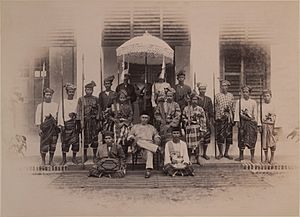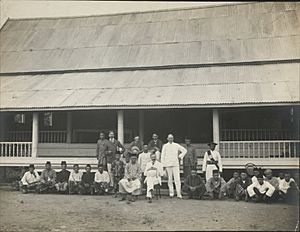Ahmad Muʽazzam facts for kids
Quick facts for kids Sultan Ahmad Al-Muʽazzam Shahأحمد المعظم شاه |
|||||
|---|---|---|---|---|---|
| Sultan of Pahang | |||||

Sultan Ahmad Al-Muʽazzam Shah and his personal attendants, 1897.
|
|||||
| Raja Bendahara of Pahang | |||||
| Reign | 10 June 1863 – 8 August 1881 | ||||
| Predecessor | Tun Mutahir | ||||
| Sultan of Pahang | |||||
| Reign | 16 August 1881 – 13 April 1909 | ||||
| Installation | 25 September 1884 | ||||
| Successor | Sultan Mahmud Shah | ||||
| Born | 23 May 1836 Pulau Maulana, Pekan, Pahang |
||||
| Died | 9 May 1914 (aged 77) Istana Pantai, Pekan, Pahang |
||||
| Burial | 11 May 1914 Royal Cemetery, Kampung Marhum, Kuala Pahang, Pahang |
||||
| Spouse | Cik Besar Yang Atur binti Abdullah Cik Amah binti Jamut Engku Besar of Terengganu Tun Besar Fatima binti Tun Muhammad Che’ Ungku Pah binti Dato’ Temenggong Sri Maharaja Tun Ibrahim Encik Zubaida binti Abdullah Cik Hajjah Fatimah binti Haji Muhammad Talib Cik Kusuma binti Tok Minal Daeng Koro Cik Santoma Cik Wan Mandak Kiri Cik Halimah Cik Bakai Cik Mah binti Awang Tukang Cik Maimunah Cik Fatimah Selat |
||||
| Issue | Tun Muda Besar Tengku Long Mahmud Tengku Ali Tengku Abdullah Tengku Sulaiman Tengku Jusoh Tengku Umar Tengku Muhammad Tengku Long Tun Salamah Tengku Dalam Tengku Nong Fatimah Tengku Hajjah Kalsum Tengku Hajjah Mariam |
||||
|
|||||
| Father | Bendahara Sri Maharaja Tun Ali Ibni Al-Marhum Tun Koris | ||||
| Mother | Cik Long Binti Encik Esah (Che Puan Lingga) | ||||
| Religion | Sunni Islam | ||||
Sultan Ahmad Al-Muʽazzam Shah (born May 23, 1836 – died May 9, 1914) was a very important ruler in Pahang's history. He was the sixth Raja Bendahara (a high-ranking official) and later became the first modern Sultan of Pahang. Before he became Sultan, people knew him as Tun Wan Ahmad.
He became the ruler in 1863 after a conflict with his older brother, Tun Mutahir. This conflict was part of the Pahang Civil War. After winning, he took the title Sri Paduka Dato' Bendahara Siwa Raja Tun Ahmad. During his early rule, there were still some challenges. His brother's sons tried to take over, which even led to Pahang getting involved in the Selangor Civil War.
In 1881, Tun Wan Ahmad decided to become Sultan Ahmad al-Muadzam Shah. This was to make his power stronger in Pahang and among other Malay states. Two years later, his chiefs officially named him Sultan. This event was very important because it brought back Pahang as a sultanate. It had been connected to the Johor kingdom for over 200 years. In 1887, the British government in the Straits Settlements officially recognized him as Sultan. In return, he signed a treaty agreeing to have a British Agent in his court.
Contents
Ruling Pahang: A Time of Change
During Sultan Ahmad's time, the British government started to get involved in Pahang's politics. British officials pushed the Sultan to rule Pahang in a "modern" way. They wanted him to follow their ideas of fair rule.
This caused some problems and disagreements between the traditional chiefs and the British. Eventually, the British convinced Sultan Ahmad to make Pahang a British protectorate in 1888. This meant Pahang was protected by Britain. John Pickersgill Rodger became Pahang's first British Resident.
The state government began to be built up. They created a Supreme Court, a police force, and a State Council. In 1895, the Sultan joined a treaty to form the Federated Malay States. This was a group of Malay states working together.
In 1909, Sultan Ahmad was getting old. He passed his ruling powers to his oldest son, Tengku Long Mahmud. However, Sultan Ahmad kept his title and position as the head of state until he passed away in 1914.
Early Life and Family Background
Sultan Ahmad was born on May 23, 1836, in Pulau Maulana, Pekan. His mother was Che Puan Long, one of the wives of Tun Ali. Tun Ali was the 22nd Bendahara of the Johor Empire.
An Arab scholar named Habib Abdullah ibni Omar Al-Attas predicted that young Wan Ahmad would have a great future. Wan Ahmad was a descendant of the 13th Bendahara, who became the 10th Sultan of Johor, Abdul Jalil Shah IV.
The Bendaharas were originally high officials who ruled Pahang as part of the Johor Sultanate. Over time, Pahang's status changed. It became more like its own kingdom. By 1853, under Sultan Ahmad's father, Pahang officially declared its independence.
Wan Ahmad received private lessons at his father's court. When he was very young, his father gave him control over the areas of Kuantan and Endau. However, after his brother became ruler in 1857, his brother challenged his control over these lands.
The Pahang Civil War
The disagreement over the lands of Kuantan and Endau led Wan Ahmad to oppose his brother, Tun Mutahir. The tension between them grew into a civil war shortly after their father died in 1857.
His older brother, Tun Mutahir, received help from Johor and the British Straits Settlements. They were against the Siamese Rattanakosin Kingdom at the time. Wan Ahmad, who was 22 years old, got help from Terengganu (a Malay sultanate to the north) and the Siamese.
Both sides had outside supporters who had their own reasons for getting involved. The fighting mostly involved raids and ambushes. There were also occasional battles near forts along Pahang's rivers. In 1862, British warships stopped Siamese ships that were trying to help Wan Ahmad.
The war ended after Wan Ahmad's troops took control of several important towns and regions. They eventually captured the capital, Pekan. Tun Mutahir retreated and later passed away in May 1863.
Wan Ahmad won the war partly because he was a very skilled military leader. After his victory, his chiefs officially made him ruler with the title Bendahara Siwa Raja Tun Ahmad. This ended the conflict between the two brothers. The new ruler showed his victory by forgiving those who had helped his enemies. He also rewarded wealthy business people who had given him money during the war. He did this by letting them control the state's salt and opium businesses.
Sultan Ahmad was honored with the title Honorary Knight Commander of the Order of St Michael and St George (KCMG) in November 1902.
Images for kids



